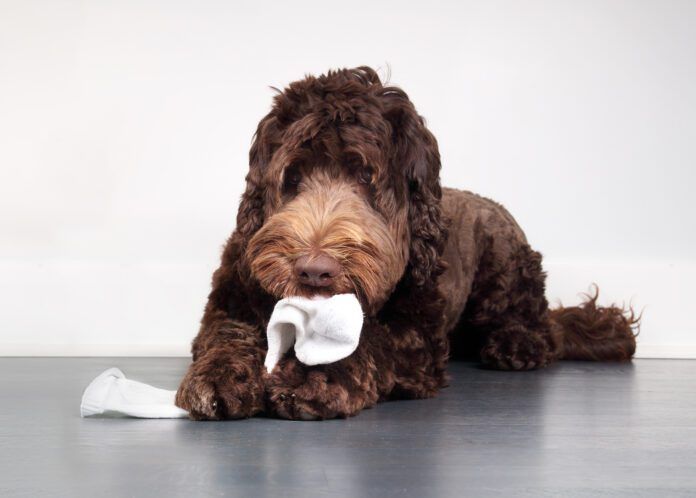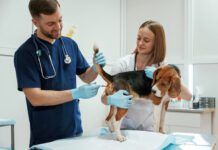Dogs are famous for eating a wide variety of non-food items, some disgusting—like feces—and some just weird—like Legos, or a ball of twine. Just this year, a 7-month-old Bernese Mountain Dog named Luna was brought to an emergency veterinarian, where x-rays showed a severely dilated stomach filled with not just food, but foreign objects, some of which were lodged in her intestines. Surgery ultimately revealed 24 socks, two hair ties and a scrunchie, a baby’s onesie, a shoe insert, and various pieces of fabric . . . in all, some 44 foreign objects.
Then there’s the case of Woof, who surgeons discovered had devoured five rubber ducks along with a tire from a toy truck. Or the two-year-old pug named Stella who was found to have eaten 104 pennies and one quarter. Or Norris, a 2-month-old rat terrier, who ate his owner’s bra.
Because all these dogs survived, we may get a laugh from such accounts of dogs behaving badly, but there’s nothing funny about a dog in severe gastric distress, or whose intestines are so blocked they’re at the point of rupturing and causing life-threatening intestinal necrosis, perforation, or sepsis.
So, as your dog’s caretaker, would you know what to do if your pup swallowed something she shouldn’t have—like a sock or a ping-pong ball?
The first thing to do is not panic. Stay as calm as possible and even if your dog isn’t showing any signs of distress, call your veterinarian and tell them what you think the dog ate, and how long ago.
NOTE: If your dog swallowed something toxic such as antifreeze, chocolate, rat poison, chemicals, or drugs in any form, or if he’s having difficulty breathing, contact your veterinarian or ASPCA Animal Poison Control (888-426-4435, 24 hours a day, 365 days a year) immediately.
Signs That Your Dog Has Ingested a Foreign Object
Sometimes, it’s easy to tell: you actually saw your pup swallow the article. Other times you might find a tipped-over garbage can, a missing sock or pair of underpants, a bottle of medicine that’s no longer where you left it on the counter, or a squeaky toy that’s lacking its squeaker.
Then there are the clinical signs that reveal your dog has eaten something he shouldn’t have. A dog who has a foreign body stuck in his esophagus will exhibit symptoms including excessive drooling, difficulty swallowing, facial pawing, unwillingness to eat, and regurgitation. If the foreign body is already in the dog’s gastrointestinal tract, you may see any of those signs plus extreme lethargy, vomiting, and abdominal pain.
Should You Watch and Wait, or Get Your Dog to the Vet?
If your dog doesn’t appear to be in distress, some vets will recommend waiting and watching, especially if you know that the object swallowed is small and round such as a marble, bead, or button. Oftentimes, these objects will pass through the gastrointestinal tract without doing any damage and will be easily excreted with the dog’s bowel movement. When something is ingested by your dog, it usually takes 10 to 24 hours to move through the entire digestive tract. Some objects, however, can take weeks or even months.
If your dog is suffering any discomfort or you know he’s swallowed a large or potentially harmful object such as a pen, needles, corncob, child’s toy, rocks, or item of clothing, you need to get to the veterinarian right away. If the ingestion occurred within the last two hours, the doctor may be able to induce vomiting. Never induce vomiting yourself without first consulting your vet: many objects and toxins are more dangerous if vomited. If the foreign body has already moved from the stomach into the intestines, or if you know your dog has ingested a toxic substance and is showing clinical signs, vomiting is unlikely to be an effective or safe option. Also, if the object is stuck in the dog’s esophagus rather than its stomach, immediate treatment is essential: complications are more likely when the foreign body has been in contact with the esophageal mucus membranes for a lengthy period.
Diagnosing Foreign Body Ingestion in Dogs
In most cases, the veterinarian will begin with a careful physical examination which includes palpating the dog’s stomach and will likely progress to taking a series of abdominal X-rays to identify the object and pinpoint its location. However, x-rays may be unable to reveal certain types of foreign objects. In that case, your veterinarian may utilize ultrasound if one is available.
Treating Dogs Who Have Swallowed Foreign Objects
Sometimes, esophageal and gastric foreign bodies can be removed using an endoscope, a medical device with a lighted flexible tube attached to forceps or snares to capture the object once the endoscope is inserted through a sedated dog’s mouth. This treatment poses little risk to the dog and is far less invasive and expensive than abdominal surgery.
Some objects, however, are very difficult or impossible to remove from the stomach endoscopically: these include corncobs, large rocks and other heavy objects, large balls, and glue. At that point, the only life-saving option is surgery. The most common procedures involve opening the stomach (gastrotomy) and opening the intestine (enterotomy). If the intestine is perforated or shows necrosis (tissue death), that portion of the gut may need to be removed. Foreign objects such as string or twine pose a special risk, because the string can wind its way into the intestine and slice into the intestinal wall.
A newer surgical treatment employs laparotomy-assisted endoscopic removal of gastrointestinal foreign bodies, which involves a combination of exploratory laparotomy and endoscopy; this technique allows direct access to and safe removal of the foreign body without an enterotomy.
Recovery and Prognosis
Without a doubt, the best prognosis for dogs who have swallowed a foreign object is when the obstruction is removed promptly, regardless of the manner of intervention. Dogs generally recover quickly when they pass the object naturally in their stool, although if the item is large or sharp, pain and damage can occur. Both endoscopic and surgical procedures have generally high rates of success in removal of foreign bodies in the upper gastrointestinal tract. Studies show that endoscopy, the procedure of choice due to its effectiveness and low invasiveness, is associated with a shorter hospitalization time compared to surgical procedures.
Regardless of the treatment strategy, without prompt medical intervention, there is a high risk of bowel wall necrosis, septic peritonitis, and death.







Many years had a Doberman that ate anything he could. Ate an entire pair of pantyhose and passed it. Along with countless socks, t shirts, cat toys, and more. Most of the time we could not even figure out where he got stuff from. But he was fine everytime. A lot of canceled appointments and plans to watch him, but oddly, nothing ever required surgery. Gorgeous rescue dog, but he had a lot of issues. Rehomed 4 times due to the fact that he was such a menace. Sweet as pie.
I had a 7 month old Great Dane that ate 36 rocks and 2 socks. I rushed him into the emergency room because I witnessed him swallowing 1 sock. I had no idea about all of the other things in his stomach. The veterinarian ended up taking x-rays to determine where the sock was only to see there was more than the one sock. He was able to get my dog to vomit the sock and some of the rocks up. Told me to keep a close eye on him and watch his poop to make sure things were passing through. Another x-ray would be taken later to make sure he was free and clear. I am always so careful in making sure to watch this boy when he is outside playing. it was evident that other family members were not so diligent. Believe me they learned a lesson the hard way. The other plus to this story is no one leaves socks laying around for dogs to swallow.
My Lab, Yukon, has pica. He eats rocks. Our landscaping is largely rocks. No problem with clothes or other items in the home. By the time he was 2 years old he had 2 surgeries and the third time they gave him 3 enemas, and he passed the rock. I finally discovered OutFox mesh masks made to prevent foxtails from entering dog’s ears and mouth. Now Yukon wears a mask every time he goes outside. It has been more than 3 years since he has eaten a rock. I will never be able to trust him outside without a mask. They have literally saved his life.
My Lab, Yukon, has pica. He eats rocks. Our landscaping is largely rocks. No problem with clothes or other items in the home, except food. He is a counter surfer. By the time he was 2 years old he had 2 surgeries and the third time they gave him 3 enemas, and he passed the rock. I finally discovered OutFox mesh masks made to prevent foxtails from entering dog’s ears and mouth. Now Yukon wears a mask every time he goes outside. It has been more than 3 years since he has eaten a rock. I will never be able to trust him outside without a mask. They have literally saved his life.
My Gracie, an Australian cattle dog mix, is a super chewer: the corners of tables, corners of cardboard boxes, her blanket, her memory foam bedding and sticks, leaves and mesquite pods.. She is now sleeping in her crate at night (without the bedding) and I give her plenty of legitimate chewing time, including the beef cheeks that were rated recently in WDJ. That seems to satisfy her need to chew. My question is, why does a well-nourished dog do this? Is it boredom?
I had an Afghan that ate an entire gingerbread house including the foil that the cardboard was wrapped in. The cardboard strangely survived and my dog was fine.
I had a rescue Airedale who vomited a pair of men’s underwear a few days after I got him. And they were huge. I’m female and single! He must have gotten it from the home he was in before. A good laugh